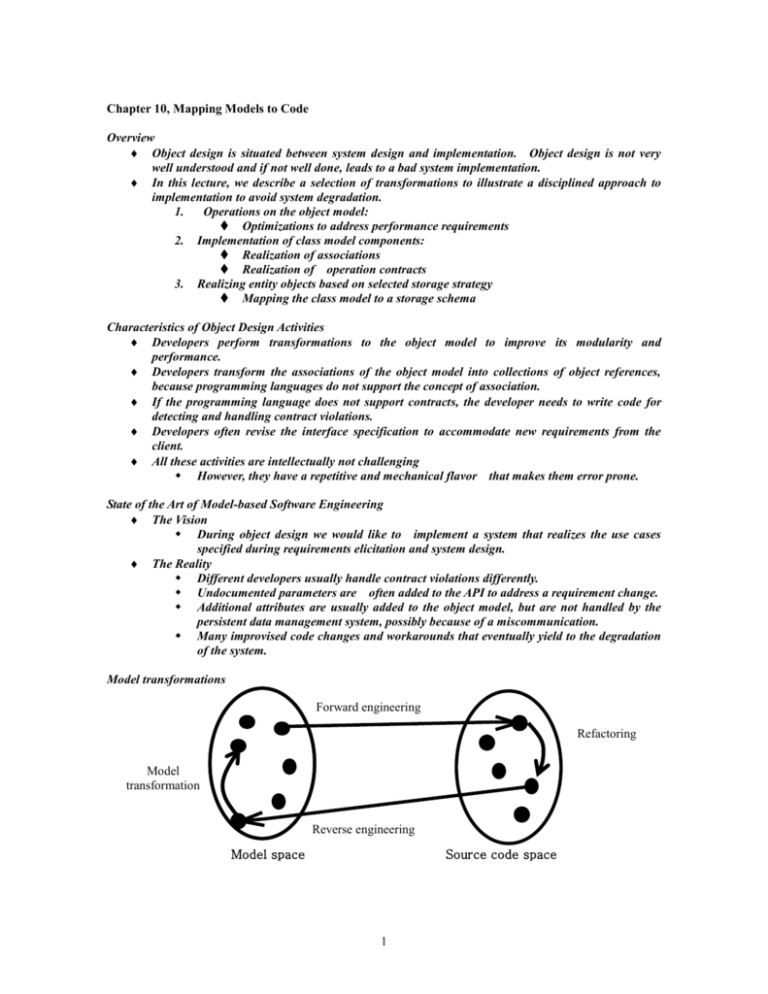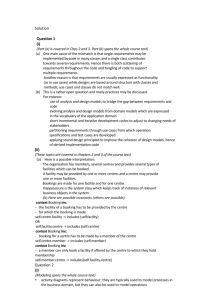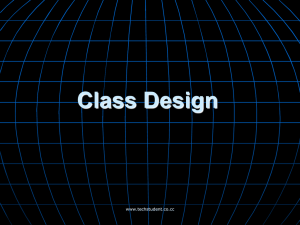Chapter 10, Mapping Models to Code Overview Object design is
advertisement

Chapter 10, Mapping Models to Code
Overview
Object design is situated between system design and implementation. Object design is not very
well understood and if not well done, leads to a bad system implementation.
In this lecture, we describe a selection of transformations to illustrate a disciplined approach to
implementation to avoid system degradation.
1.
Operations on the object model:
Optimizations to address performance requirements
2. Implementation of class model components:
Realization of associations
Realization of operation contracts
3. Realizing entity objects based on selected storage strategy
Mapping the class model to a storage schema
Characteristics of Object Design Activities
Developers perform transformations to the object model to improve its modularity and
performance.
Developers transform the associations of the object model into collections of object references,
because programming languages do not support the concept of association.
If the programming language does not support contracts, the developer needs to write code for
detecting and handling contract violations.
Developers often revise the interface specification to accommodate new requirements from the
client.
All these activities are intellectually not challenging
However, they have a repetitive and mechanical flavor that makes them error prone.
State of the Art of Model-based Software Engineering
The Vision
During object design we would like to implement a system that realizes the use cases
specified during requirements elicitation and system design.
The Reality
Different developers usually handle contract violations differently.
Undocumented parameters are often added to the API to address a requirement change.
Additional attributes are usually added to the object model, but are not handled by the
persistent data management system, possibly because of a miscommunication.
Many improvised code changes and workarounds that eventually yield to the degradation
of the system.
Model transformations
Forward engineering
Refactoring
Model
transformation
Reverse engineering
Model space
Source code space
1
Model Transformation Example: Fig 10-2
Refactoring: Fig 10-3,4
Pull Up Field
Pull Up Constructor Body
Pull Up Method
Forward Engineering Example: Fig 10-5
Object design model before transformation
LeagueOwner
+maxNumLeagues:int
User
+email:String
+notify(msg:String)
Source code after transformation
public class User {
public class LeagueOwner extends
private String email;
User {
public String getEmail() {
private int maxNumLeagues;
return email;
public int getMaxNumLeagues() {
}
return maxNumLeagues;
public
void
setEmail(String
}
value){
public void setMaxNumLeagues
email = value;
(int value) {
}
maxNumLeagues = value;
public void notify(String msg) {
// ....
}
}
/* Other methods omitted */
/* Other methods omitted */
}
}
Optimizing the Object Design Model
Collapsing an object without interesting behavior: Fig 10-6
Delaying expensive computations: Fig 10-7
Proxy design pattern
Mapping Associations
Realization of a unidirectional, one-to-one association: Fig 10-8
Bidirectional one-to-one association: Fig 10-9
Bidirectional, one-to-many association: Fig 10-10
Bidirectional, many-to-many association: Fig 10-11
Bidirectional qualified association: Fig 10-12
Transformation of an association class: Fig 10-13
Mapping Contracts to Exceptions
Exceptions as building blocks for contract violations
Many object-oriented languages, including Java do not include built-in support for contracts.
However, we can use their exception mechanisms as building blocks for signaling and
handling contract violations
In Java we use the try-throw-catch mechanism
2
Example:
Let us assume the acceptPlayer() operation of TournamentControl is invoked with a
player who is already part of the Tournament.
In this case acceptPlayer() should throw an exception of type KnownPlayer.
See source code on next slide
The try-throw-catch Mechanism in Java
public class TournamentControl {
private Tournament tournament;
public void addPlayer(Player p) throws KnownPlayerException {
if (tournament.isPlayerAccepted(p)) {
throw new KnownPlayerException(p);
}
//... Normal addPlayer behavior
}
}
public class TournamentForm {
private TournamentControl control;
private ArrayList players;
public void processPlayerApplications() { // Go through all the
players
for (Iteration i = players.iterator(); i.hasNext();) {
try {
// Delegate to the control object.
control.acceptPlayer((Player)i.next());
} catch (KnownPlayerException e) {
// If an exception was caught, log it to the
console
ErrorConsole.log(e.getMessage());
}
}
}
}
Implementing a contract
For each operation in the contract, do the following
Check precondition: Check the precondition before the beginning of the method with a test
that raises an exception if the precondition is false.
Check postcondition: Check the postcondition at the end of the method and raise an exception
if the contract is violoated. If more than one postcondition is not satisfied, raise an exception
only for the first violation.
Check invariant: Check invariants at the same time as postconditions.
Deal with inheritance: Encapsulate the checking code for preconditions and postconditions
into separate methods that can be called from subclasses.
Heuristics for Mapping Contracts to Exceptions
Be pragmatic, if you don’t have enough time.
Omit checking code for postconditions and invariants.
Usually redundant with the code accomplishing the functionality of the class
Not likely to detect many bugs unless written by a separate tester.
Omit the checking code for private and protected methods.
Focus on components with the longest life
Focus on Entity objects, not on boundary objects associated with the user interface.
Reuse constraint checking code.
Many operations have similar preconditions.
Encapsulate constraint checking code into methods so that they can share the same
exception classes.
3
Mapping Object Models to a Persistent Storage Schema
Mapping an object model to a relational database
UML object models can be mapped to relational databases:
Some degradation occurs because all UML constructs must be mapped to a single
relational database construct - the table.
UML mappings
Each class is mapped to a table
Each class attribute is mapped onto a column in the table
An instance of a class represents a row in the table
A many-to-many association is mapped into its own table
A one-to-many association is implemented as buried foreign key
Methods are not mapped
Mapping the User class to a database table: Fig 10-18
Primary and Foreign Keys: Fig 10-16,17
Any set of attributes that could be used to uniquely identify any data record in a relational table
is called a candidate key.
The actual candidate key that is used in the application to identify the records is called the
primary key.
The primary key of a table is a set of attributes whose values uniquely identify the
data records in the table.
A foreign key is an attribute (or a set of attributes) that references the primary key of another
table.
Buried Association: Fig 10-19
Associations with multiplicity one can be implemented using a foreign key.
For one-to-many associations we add a foreign key to the table representing the class on the
“many” end.
For all other associations we can select either class at the end of the association.
Associations with multiplicity “one” can be implemented using a foreign key. Because the
association vanishes in the table, we call this a buried association.
Mapping Many-To-Many Associations: Fig 10-20
Separate two column table with foreign keys for both classes of the association
Realizing Inheritance
Relational databases do not support inheritance
Two possibilities to map UML inheritance relationships to a database schema
With a separate table (vertical mapping) : Fig 10-21
The attributes of the superclass and the subclasses are mapped to different
tables
By duplicating columns (horizontal mapping) : Fig 10-22
There is no table for the superclass
Each subclass is mapped to a table containing the attributes of the subclass and
the attributes of the superclass
Comparison: Separate Tables vs Duplicated Columns
The trade-off is between modifiability and response time
How likely is a change of the superclass?
What are the performance requirements for queries?
Separate table mapping
We can add attributes to the superclass easily by adding a column to the superclass
table
4
Searching for the attributes of an object requires a join operation.
Duplicated columns
Modifying the database schema is more complex and error-prone
Individual objects are not fragmented across a number of tables, resulting in faster
queries
Heuristics for Transformations
For a given transformation use the same tool
If you are using a CASE tool to map associations to code, use the tool to change
association multiplicities.
Keep the contracts in the source code, not in the object design model
By keeping the specification as a source code comment, they are more likely to be
updated when the source code changes.
Use the same names for the same objects
If the name is changed in the model, change the name in the code and or in the database
schema.
Provides traceability among the models
Have a style guide for transformations
By making transformations explicit in a manual, all developers can apply the
transformation in the same way.
Summary
Undisciplined changes => degradation of the system model
Four mapping concepts were introduced
Model transformation improves the compliance of the object design model with a design
goal
Forward engineering improves the consistency of the code with respect to the object
design model
Refactoring improves the readability or modifiability of the code
Reverse engineering attempts to discover the design from the code.
We reviewed model transformation and forward engineering techniques:
Optiziming the class model
Mapping associations to collections
Mapping contracts to exceptions
Mapping class model to storage schemas
More Terminology
Roundtrip Engineering
Forward Engineering + reverse engineering
Inventory analysis: Determine the Delta between Object Model and Code
Together-J and Rationale provide tools for reverse engineering
Reengineering
Used in the context of project management:
Provding new functionality (customer dreams up new stuff) in the context of new
technology (technology enablers)
Restructuring Activities
Realizing associations
Revisiting inheritance to increase reuse
Revising inheritance to remove implementation dependencies
Realizing Associations
Strategy for implementing associations:
5
Be as uniform as possible
Individual decision for each association
Example of uniform implementation
1-to-1 association:
Role names are treated like attributes in the classes
references
1-to-many association:
"Ordered many" : Translate to Vector
"Unordered many" : Translate to Set
Qualified association:
Translate to Hash table
and translate to
Increase Inheritance
Rearrange and adjust classes and operations to prepare for inheritance
Abstract common behavior out of groups of classes
If a set of operations or attributes are repeated in 2 classes the classes might be special
instances of a more general class.
Be prepared to change a subsystem (collection of classes) into a superclass in an inheritance
hierarchy.
Building a super class from several classes
Prepare for inheritance. All operations must have the same signature but often the signatures do not
match:
Some operations have fewer arguments than others: Use overloading (Possible in Java)
Similar attributes in the classes have different names: Rename attribute and change all
the operations.
Operations defined in one class but no in the other: Use virtual functions and class
function overriding.
Abstract out the common behavior (set of operations with same signature) and create a superclass
out of it.
Superclasses are desirable. They
increase modularity, extensibility and reusability
improve configuration management
Turn the superclass into an abstract interface if possible
Use Bridge pattern
Object Design Areas
1. Service specification
A. Describes precisely each class interface
2. Component selection
A. Identify off-the-shelf components and additional solution objects
3. Object model restructuring
A. Transforms the object design model to improve its understandability and extensibility
4. Object model optimization
A. Transforms the object design model to address performance criteria such as response
time or memory utilization.
Design Optimizations
Design optimizations are an important part of the object design phase:
A. The requirements analysis model is semantically correct but often too inefficient if
directly implemented.
Optimization activities during object design:
A. Add redundant associations to minimize access cost
B. Rearrange computations for greater efficiency
6
C. Store derived attributes to save computation time
As an object designer you must strike a balance between efficiency and clarity.
A. Optimizations will make your models more obscure
Design Optimization Activities
0. Add redundant associations:
What are the most frequent operations? ( Sensor data lookup?)
How often is the operation called? (30 times a month, every 50 milliseconds)
1. Rearrange execution order
Eliminate dead paths as early as possible (Use knowledge of distributions, frequency of
path traversals)
Narrow search as soon as possible
Check if execution order of loop should be reversed
2. Turn classes into attributes
Implement Application domain classes
To collapse or not collapse: Attribute or association?
Object design choices:
Implement entity as embedded attribute
Implement entity as separate class with associations to other classes
Associations are more flexible than attributes but often introduce unnecessary indirection.
Abbott's textual analysis rules
Every student receives a number at the first day in in the university.
Optimization Activities: Collapsing Objects
To Collapse or not to Collapse?
Collapse a class into an attribute if the only operations defined on the attributes
are Set() and Get().
Design Optimizations (continued)
Store derived attributes
Example: Define new classes to store information locally (database cache)
Problem with derived attributes:
Derived attributes must be updated when base values change.
There are 3 ways to deal with the update problem:
Explicit code: Implementor determines affected derived attributes (push)
Periodic computation: Recompute derived attribute occasionally (pull)
Active value: An attribute can designate set of dependent values which are
automatically updated when active value is changed (notification, data trigger)
Optimization Activities: Delaying Complex Computations
Increase Inheritance
Rearrange and adjust classes and operations to prepare for inheritance
Generalization: Finding the base class first, then the sub classes.
Specialization: Finding the the sub classes first, then the base class
Generalization is a common modeling activity. It allows to abstract common behavior out of a
group of classes
If
a set of operations or attributes are repeated in 2 classes the classes might be special
instances of a more general class.
Always check if it is possible to change a subsystem (collection of classes) into a superclass in an
inheritance hierarchy.
Generalization: Building a super class from several classes
You need to prepare or modify your classes for generalization.
All operations must have the same signature but often the signatures do not match:
7
Some operations have fewer arguments than others: Use overloading (Possible in Java)
Similar attributes in the classes have different names: Rename attribute and change all
the operations.
Operations defined in one class but no n the other: Use virtual functions and class
function overriding.
Superclasses are desirable. They
increase modularity, extensibility and reusability
improve configuration management
Many design patterns use superclasses
Try to retrofit an existing model to allow the use of a design pattern
Implement Associations
Two strategies for implementing associations:
1. Be as uniform as possible
2. Make an individual decision for each association
Example of a uniform implementation (often used by CASE tools)
1-to-1 association:
Role names are treated like attributes in the classes and translate to references
1-to-many association:
Always Translate into a Vector
Qualified association:
Always translate into to Hash table
8







